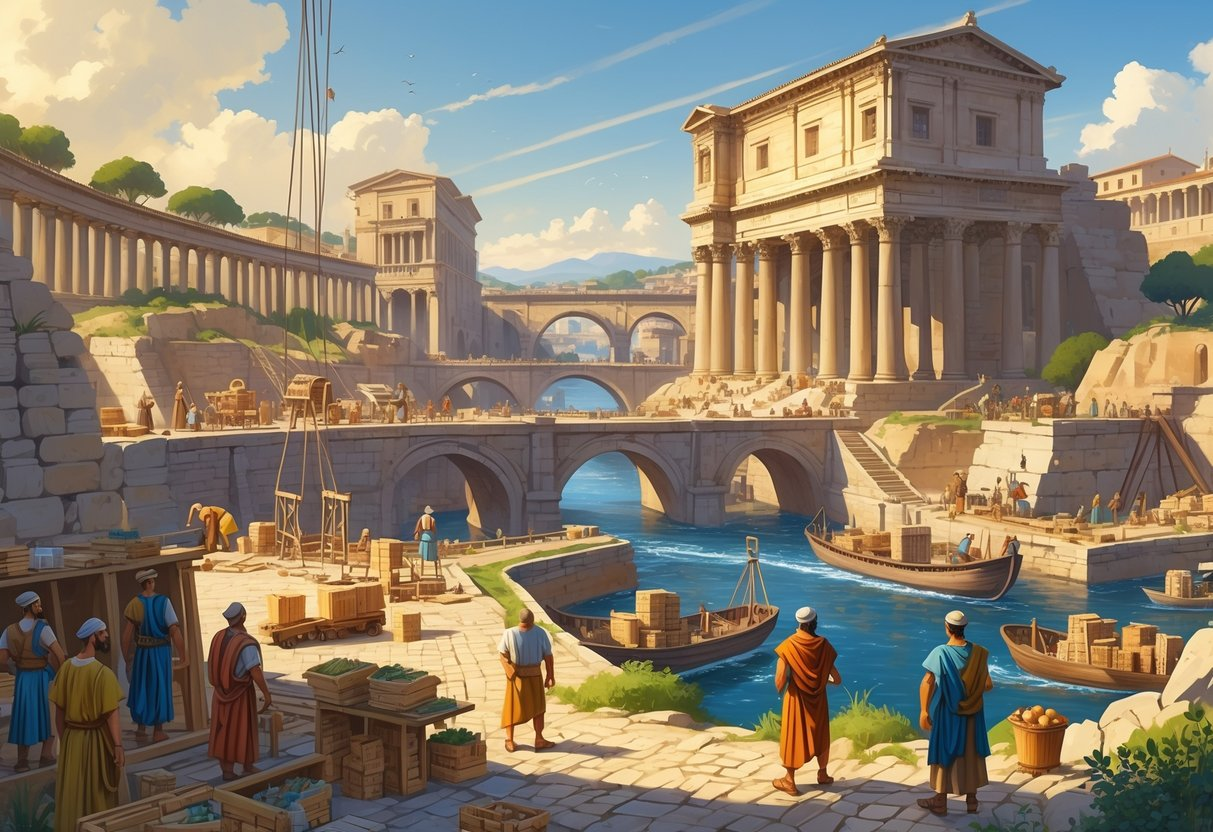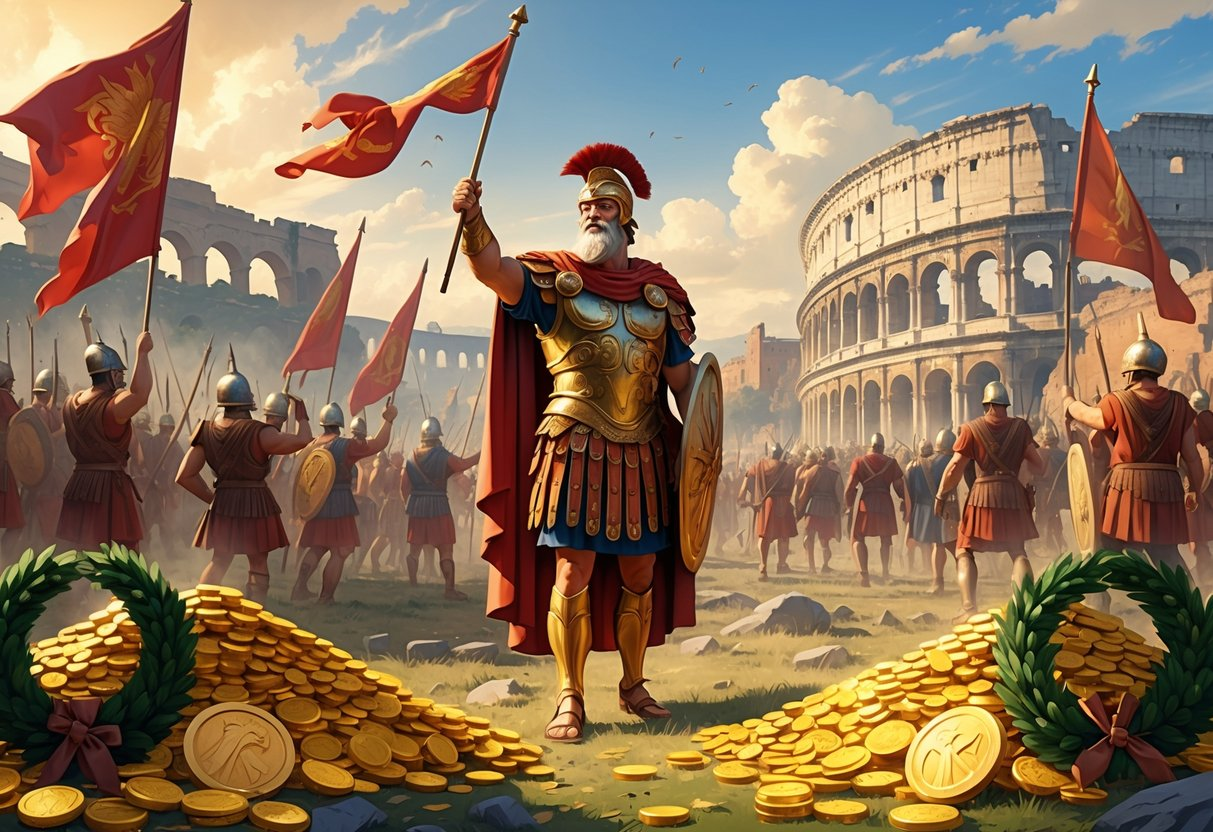At the height of the Middle Ages, Constantinople was the crossroads of continents and cultures. Its walls guarded emperors, churches, and the massive wealth of an empire that connected East and West.
Constantinople was the economic heart of the medieval world, shaping trade, politics, and culture across Europe and Asia.

Its power came from more than just geography. Sitting between the Black Sea and the Mediterranean, Constantinople controlled key routes for goods like silk, spices, and grain.
Merchants from Venice, Genoa, and the Islamic world thrived in its lively markets. The city’s rulers used strict regulations and taxes to manage this flow of wealth, turning commerce into imperial strength.
Over time, this wealth fueled art, religion, and intellectual life. Constantinople became a symbol of Byzantine identity, with its monuments and institutions reflecting both faith and prosperity.
Constantinople’s Strategic Location and Rise as an Economic Power

Constantinople’s location gave it unmatched control over trade between Europe and Asia. Its natural defenses and political role helped it grow from a modest polis into the economic center of the Byzantine Empire.
Geographical Advantages Between Europe and Asia
Constantinople sat on the Bosphorus Strait, the narrow waterway linking the Black Sea and the Sea of Marmara. This spot let the city monitor and tax ships sailing between the Mediterranean Sea and the Middle East.
The peninsula’s steep hills and surrounding waters made it tough to invade. Harbors like the Golden Horn boosted trade and naval power.
Merchants from Asia and Europe swapped goods like silk, spices, and grain, turning Constantinople into a major commerce hub. Its natural setting gave it strategic and economic importance few other medieval cities could match.
Transformation from Byzantium to Constantinople
Before it was Constantinople, the city was called Byzantium, a Greek settlement by the Bosphorus. Emperor Constantine the Great saw its potential and rebuilt it as the new capital of the Roman Empire in 330 CE.
He expanded the walls, upgraded infrastructure, and built monumental buildings to show off imperial power. The transformation turned a small trading town into a booming imperial metropolis.
By controlling trade routes between Ankara, the Middle East, and the Mediterranean, Constantinople became a crossroads of cultures and economies.
Role as the Capital of the Byzantine Empire
As the capital of the Byzantine Empire, Constantinople was the empire’s administrative, religious, and commercial center. Its wealth came from taxes on trade and manufacturing like textiles and metalwork.
The city’s government regulated prices, kept the grain flowing, and maintained trade routes across Europe and Asia. Its coin, the solidus, became a stable currency used all over the Mediterranean.
Constantinople’s political and economic influence made it one of the most powerful urban centers in the medieval world.
Trade Networks and Economic Regulation

Constantinople linked the Mediterranean Sea, the Black Sea, and inland routes to Asia. This made it a central hub for goods, merchants, and taxes.
Its government kept a balance between control and openness, using trade laws, guild regulation, and monopolies to manage business across the Byzantine Empire.
Major Trade Routes and Maritime Connections
Constantinople sat at the crossroads of major trade routes connecting Europe and Asia. Ships from Egypt, Italy, and the Crimea sailed through its harbors with grain, spices, silk, and metals.
The city’s spot on the Bosporus made it a natural checkpoint for goods moving between the Black Sea and the Mediterranean. Merchants from Venice, Genoa, and the Rus traded there under imperial supervision.
These connections tied the Byzantine economy to far-off places like the Near East and Central Asia. By the late Middle Ages, Constantinople’s maritime networks shaped trade patterns that would later support the Age of Exploration.
Guilds, the Book of the Eparch, and Market Oversight
Economic regulation in Constantinople was all about oversight. The Book of the Eparch, a tenth-century manual, spelled out the duties of guilds and market officials.
Bakers, butchers, silk workers, and money changers all worked under state control. Guilds made sure products were good quality and fairly priced, while also protecting local craftsmen from foreign competition.
The Eparch, or city governor, enforced these rules and watched over trade in key goods. This system kept markets stable and cut down on monopolies outside imperial authority.
Silk Trade and Byzantine Silk Monopoly
Silk was one of Constantinople’s hottest commodities. The Byzantine silk monopoly started after the sixth century when silkworms were smuggled in from China.
Production was limited to imperial workshops, and trade was tightly controlled. Artisans wove silk for the court, clergy, and export.
The empire used silk as both currency and a diplomatic gift. These textiles spread widely through Mediterranean trade networks.
Control over silk gave the empire a lot of economic power. It also drew merchants from Italy and the Islamic world who wanted access to Byzantine fabrics.
Foreign Merchants and International Commerce
Foreign merchants were a big part of Constantinople’s economy. Venetians and Genoese got trading privileges in exchange for naval support, setting up colonies in the city’s harbors.
The Rus brought furs and slaves through the Black Sea. Traders from the Levant supplied spices and textiles.
These communities operated under imperial treaties that set taxes and duties. Their activity linked Byzantine markets to Western Europe and the Islamic world.
This mix of regulation and openness kept Constantinople a vital commercial hub right up until the Ottoman conquest.
Imperial Influence, Religion, and Cultural Flourishing
Imperial power in Constantinople shaped trade, religion, and the arts across the medieval world. Rulers directed the economy, supported Christian institutions, and built monuments that showed off both faith and authority.
Role of Emperors in Economic Policy
Emperors like Constantine I and Justinian I used state control to boost commerce and city development. Constantine’s founding of Constantinople as a new capital shifted trade routes toward the eastern Mediterranean.
Justinian I reformed taxation and trade laws, making sure there was money for military campaigns and big building projects like the Hagia Sophia. His policies encouraged merchants from Venice and Pisa to set up shop in the city.
Later emperors, including Basil I and Basil II, kept a close eye on the finances. They controlled grain imports, supervised guilds, and managed the treasury from the Great Palace.
| Emperor | Economic Focus | Outcome |
|---|---|---|
| Constantine I | Founded city, reoriented trade | Created major commercial hub |
| Justinian I | Legal and tax reforms | Funded large-scale building |
| Basil II | Fiscal discipline | Sustained long prosperity |
Religious Institutions and the Economy
Religion played a big part in Constantinople’s economy. The Eastern Orthodox Church owned land, collected tithes, and managed charities that supported trade and city life.
After the Council of Nicaea, emperors promoted Christianity to unify the empire. Theodosius II and Heraclius funded churches and monasteries, which became centers of production and education.
Major shrines like the Church of the Holy Apostles drew pilgrims, which boosted markets for artisans and innkeepers. By the time of the Schism of 1054, the city’s religious wealth was tightly linked to its political power.
Architectural and Cultural Achievements
Imperial and religious support made Constantinople a center of art and innovation. Justinian I built the Hagia Sophia, famous for its massive dome and mosaics.
Public venues like the Hippodrome hosted chariot races, which were both fun and a way to build loyalty to the emperor. The Imperial Palace complex showed off luxury and power, influencing court architecture far and wide.
Artists and craftsmen created advanced mosaics for churches and palaces, mixing classical and Christian styles. These works showed off both faith and imperial pride, making the city the cultural heart of the medieval Mediterranean.
Decline, Legacy, and Transformation
Constantinople’s decline came from centuries of military pressure, changing trade routes, and internal problems. Its transformation under Ottoman rule and later as Istanbul reshaped commerce, religion, and identity, connecting the medieval past to the modern world.
Sieges, Crusades, and the Fall of Constantinople
Constantinople went through a lot of attacks that wore down its defenses and economy. The Fourth Crusade in 1204 was a huge moment—Latin forces took over, looted the city, and threw Byzantine power and trade into chaos.
This event left deep political and cultural fractures, as described in The Latin Renovatio of Byzantium. Later on, the city faced the rising power of the Ottoman Empire.
By 1453, Mehmed II showed up with gunpowder and giant cannons, blasting through the famous Theodosian Walls. The fall of Constantinople brought the Byzantine Empire to an end and changed the balance of power in Europe and Asia.
The city’s capture also meant the end of “New Rome,” the last bit of the Christian Roman Empire. Churches, markets, and old fortifications—once guarded with Greek fire—became reminders of a lost era.
Ottoman Conquest and Economic Shifts
Once the Ottomans took over, Constantinople turned into a bustling imperial capital. Mehmed II got to work rebuilding, reopening trade routes through the Golden Horn, and inviting merchants from all over Asia, Africa, and Europe.
The transformation is detailed in The fall of Constantinople to the Ottomans: context and consequences, showing how the Ottomans picked up and grew the city’s economic networks. The Ottomans plugged Constantinople into a global trade web connecting the Mediterranean, the Silk Road, and the Indian Ocean.
Guilds, shipyards, and markets did well under imperial watch. The city’s look changed too—mosques and palaces took the place of Byzantine churches.
Still, commerce, finance, and craftsmanship kept the city’s economic heart beating.
Enduring Impact on Trade and Modern Istanbul
The fall of the city reshaped trade across the Mediterranean. As Ottoman control grew, European powers started searching for new sea routes to Asia.
Constantinople’s spot between continents kept it important as a commercial and cultural center.
After the First World War, the Republic of Turkey was established, and Constantinople became Istanbul. The city’s strategic location on the Golden Horn and Bosporus still makes it a big player in global trade and politics.
Modern Istanbul still shows off its layered history. The markets that once served Byzantine emperors and Ottoman sultans now supply a modern city.



Leave a Reply